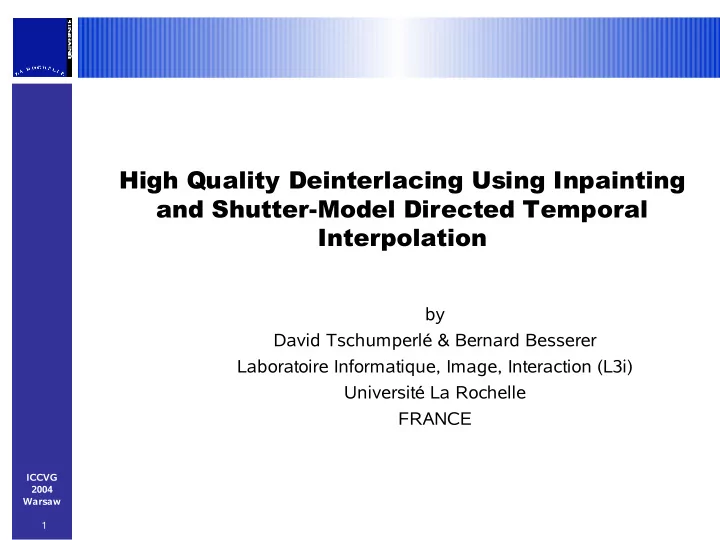

High Quality Deinterlacing Using Inpainting and Shutter-Model Directed Temporal Interpolation by David Tschumperlé & Bernard Besserer Laboratoire Informatique, Image, Interaction (L3i) Université La Rochelle FRANCE ICCVG 2004 Warsaw 1
Overview Description of a High Quality (HQ) de-interlacing process. Main application : Tape to film blow-up Applied research : Chaining and Adaptation of well known methods (inpainting, motion estimation, warp filters) Contents of the talk : • Film and video image capture, an overview • What is de-interlacing • Process description • Results, Conclusion, Future Works ICCVG 2004 Warsaw 2
Overview : film camera exposition Image capture is progressive ARRI for film cameras 35mm Exposition is full frame A rotating shutter covers the film during transport and uncover the film during exposure time Variable exposure = variable angle for the open sector if motion motion blur (integration over time) ICCVG 2004 Warsaw Optical axis 3
Overview : video camera integration Video ( PAL/SECAM, NTSC ) is interlaced For most of the CCD arrays used, image integration is interlaced Integration time is short If motion : the playback is smooth, because rendering device (TV set) is also interlaced But if looking at a still image, the "comb" effect become visible ICCVG 2004 Warsaw 4
De-interlacing Real time deinterlacing (DVD player if paused) BOB / WEAVE Motion adaptive de- WEAVE : shows interlacing : switch between both fields BOB and Weave according to motion Other approaches use : Fourier analysis T-shaped spatio-temporal BOB : doubles the lines filters ... ICCVG 2004 Warsaw 5
HQ de-interlacing : Why ? D-cinema rush (digital from camera to projection) : few theatres are equipped - in which countries ?. What is the standard ? (16mm and 35mm reels are standard worldwide) Producing on video is inexpensive : for low budget feature films, documentaries, commercials,… but film distribution goes trough the ( 35mm equipped ) film theatres Broadcast - DVD Film recorder De-interlacing & blow-up Editing Preservation : Polyester film is very stable (estimated > 500 years) while digital media is evanescent (remember, the 5 1/4 floppies, used only a decade ago, with 720 Ko data on it) ICCVG 2004 Warsaw 6
Our challenge Achieve high quality de-interlacing for both moving and steady shots Simulate the progressive integration create motion blur Maintain image quality even if resized to higher resolution We have to estimate the motion between fields ICCVG 2004 Warsaw 7
HQ de-interlacing : 1st step Create an accurate "full frame" from a single field It's a spatial interpolation, but : These frames will be used for motion estimation (H&S method), so the edges should be well recovered Inpainting : PDE regularization of tensor images Each point of the image is an smoothed structure tensor : holds information about the local image structure (isophote direction) U : [w, h] [0, 255] 3 (color image) Filling the blank lines : average each set of two lines in the direction of the estimated color isophotes ICCVG 2004 Warsaw Check previous work of David Tschumperlé for more information 8
HQ de-interlacing : 2nd step A motion estimation is needed : for temporal decimation from 50 interpolated frames/sec to 25 frames/sec and for a temporal integration scheme Well-known Horn & Schunck method Forward and backward motion fields are computed forward motion (odd to even), backward motion (even to odd) not exactly opposed vector fields : occlusions, noise. ICCVG 2004 Warsaw 9
HQ de-interlacing : 3rd step Integration to produce the output images S(t) represents what we call the shutter characteristic function : surface uncovered and covered by the rotating shutter. ICCVG 2004 Warsaw 10
HQ de-interlacing : last step Resizing Video resolution : 720 X 576 Image recorder : 2K (2048 X 1536) or 4K (4096 X 3072) HDTV (1920 X 1080) Edge enhancement : traditional high-pass methods raise noise... Warp filter : moving information according to image gradient. Related to tensor images and From video to 2K : From video to 2K : regularisation our de-interlacing bilinear interpolation scheme + warp ICCVG filter 2004 Warsaw 11
Overall workflow ICCVG 2004 Warsaw 12
Results The torch juggler... Interlaced original image ICCVG 2004 Warsaw 13
Results Odd field Even field ICCVG 2004 Warsaw 14
Results Forward motion Backward motion vectors vectors ICCVG 2004 Warsaw 15
Results De-interlaced image after Deinterlaced image warp filter (no resizing) ICCVG 2004 Warsaw 16
Conclusion / Future works Very good results Slow, requires a lot of computational power Fortunately, image recorder are also slow (several seconds / image) Improvement in speed and user feedback while adjusting parameters Future works Complete retiming (from 25 to 24 frames/sec) Thank you for your attention ICCVG 2004 Warsaw 17
Recommend
More recommend